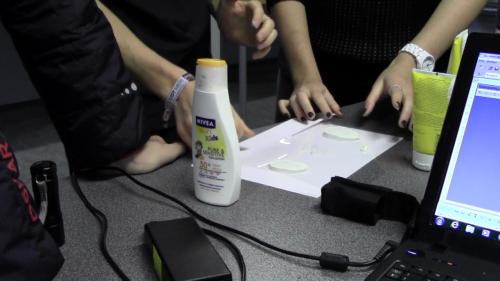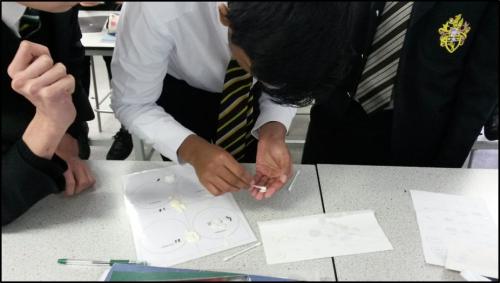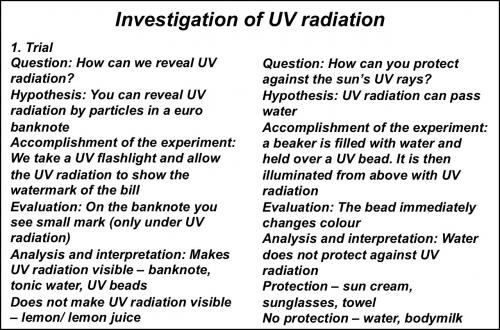In the Ultraviolet radiation SAILS inquiry and assessment unit, four activities are presented for introducing the concept of UV radiation. In particular, this unit addresses sources of UV radiation, potential health and safety considerations and methods of detection of UV radiation. The investigations suggested are carried out using UV reactive beads (UV sensors). These activities are suitable for implementation with lower second level students (aged 12-16 years). The unit activities are presented with open/guided inquiry approaches and implementation of the complete unit is expected to take about 3 hours.
Activity A introduces students to the methods of observing UV irradiation, in particular fluorescence, and promotes students’ familiarity with the handling of UV beads. In Activity B, the students consider real world impacts of UV rays and how to reduce exposure. The final two activities build on these experiences and encourage students to investigate the intensity of UV rays and UV sources.
This unit can be used for development of many inquiry skills, in particular planning investigations. In addition, students can develop their skills in developing hypotheses and forming coherent arguments, and enhance their scientific reasoning and scientific literacy. Possible assessment opportunities include teacher observation, student artefacts, use of rubrics and peer- and self-assessment.
This unit was trialled by teachers in Denmark, UK and Germany – producing three case studies of its implementation. The skills of developing hypotheses and planning investigations were assessed in all case studies and assessment of working collaboratively and scientific reasoning was also described.
- Sources of UV radiation
- Detecting exposure levels to UV radiation
- How to reduce UV exposure
- Lower
- Planning investigations
- Developing hypotheses
- Forming coherent arguments
- Working collaboratively
- Scientific reasoning
- Scientific literacy
- Classroom dialogue
- Teacher observation
- Peer-assessment
- Self-assessment
- Worksheets
- Student devised materials
- Presentations
The activities in the Ultraviolet radiation SAILS inquiry and assessment unit were based on the article To Tan or Not to Tan? Students learn about sunscreens through an inquiry activity based on the learning cycle. The teaching and learning activities were adapted for the SAILS project by the team at Kristianstad University.
In this unit, four activities are outlined, that are suitable for introducing lower second level students (aged 12-16 years) to the topic of ultraviolet radiation. These activities develop student understanding of the harmful effects of solar radiation and what preventative measures can be taken to reduce the risks associated with exposure to UV sources, e.g. sunlight. During this unit, students use UV beads – polymeric beads that change colours when irradiated with UV light – to investigate how to detect “invisible” light. This unit is very suitable for use with an open inquiry approach, as students generally have lots of ideas that they want to test. Students will be stimulated to formulate their own questions (developing hypotheses) and design suitable experiments to carry out (planning investigations). In addition, students develop their scientific reasoning and scientific literacy skills through analysing, interpreting and reporting their results.
When implementing these unit activities, it is important that the assessment is in line with the objectives of the topic and the curriculum. It is also important that students understand how to report their results and how they will be judged, before they carry out the activities. This inquiry and assessment unit recommends that planning investigations is a key inquiry skill that can be developed during the unit activities, which can be assessed using a 3-level rubric. This unit is also suitable for assessment of developing hypotheses, as students are asked to make predictions regarding how UV light can be detected, what materials can provide protection from UV radiation and what are sources of UV radiation.
To assess students’ scientific reasoning capabilities and skill in forming coherent arguments, a 3-level rubric may be used for assessing students’ skills in interpreting results, drawing conclusions, as well as documenting and discussing, The activities in this unit may also be used to assess students’ skills in collecting, documenting, and analysing data, again allowing them to demonstrate their scientific reasoning capabilities. These activities allow the teacher to assess students’ ability to document an investigation in text and with pictures (using graphs, tables and symbols) and using documentation in their discussion of results and conclusions. Finally, assessment of students’ observation skills can be achieved, looking at identifying properties, finding similarities and differences, and describing objects in words and drawings.
Below you can find the full inquiry and assessment unit for download, as well as an archive with classroom materials, including student worksheets and assessment tools for teachers to be used during the activities if available.
Unit booklet Classroom materials| Concept focus |
Introduction to UV radiation
Detection of UV radiation and fluorescence
|
| Inquiry skills focus |
Planning investigations
Developing hypotheses
Working collaboratively
|
| Scientific reasoning |
Forming conclusions
|
| Assessment methods |
Classroom dialogue
Teacher observation
|
| Concept focus |
Protection from UV radiation
Energy of UV rays
|
| Inquiry skills focus |
Planning investigations
Developing hypotheses
Working collaboratively
|
| Scientific reasoning |
Forming conclusions
|
| Scientific literacy |
Real world context
|
| Assessment methods |
Classroom dialogue
Student devised materials
|
| Concept focus |
Intensity of UV radiation
|
| Inquiry skills focus |
Planning investigations
Developing hypotheses
|
| Scientific reasoning |
Forming conclusions
|
| Scientific literacy |
Real world context
|
| Assessment methods |
Classroom dialogue
Student devised materials
|
| Concept focus |
Sources of UV radiation
|
| Inquiry skills focus |
Planning investigations
Developing hypotheses
|
| Scientific literacy |
Real world context
|
| Assessment methods |
Classroom dialogue
Student devised materials
|
This unit was trialled in three countries – CS1 Denmark, CS2 United Kingdom and CS3 Germany. Three case studies have been compiled from classroom implementation by three science teachers in a total of four classes. The activities have been carried out with lower second level students; classes were mainly of mixed gender, but in CS2 United Kingdom the class consisted of only boys. All of the case studies were implemented by teachers who had some experience of teaching through inquiry, but the students involved had limited experience of inquiry learning.
CS1 Denmark consisted of a class of 24 students aged 14-16 years, working in groups of 4-5 students, and CS2 United Kingdom describes a class of 26 all-male students, aged 14-15 years, who were “top set” performers (high ability). Finally, CS3 Germany involved a mixed ability and gender class of 30 students, aged 14-15 years. Activity B: How can you protect yourself from the sun’s rays? was implemented in all case studies, while CS1 Denmark also implemented activities A and D, and CS3 Germany implemented activities A and B.
All case studies describe assessment of the skills of developing hypotheses, planning investigations and scientific reasoning, primarily through classroom dialogue and evaluation of student presentations. CS2 United Kingdom describes use of peer-assessment of poster presentations and self-assessment of the skill of working collaboratively.
The inquiry approach varied in each of the case studies: open inquiry in CS1 Denmark, bounded inquiry in CS2 United Kingdom and guided inquiry in CS3 Germany. In all cases teacher posed the initial question but there were different approaches in how the students decided to address the question. Students completed the activities working in small groups and peer discussion was encouraged and facilitated. In each of the case studies, teachers used the real world context of prevention of sunburn to encourage students to explore their knowledge of UV radiation. Implementation and teaching approach varied, depending on the needs of the class and skills to be assessed.
Within the three case studies, the inquiry skills of planning investigations and developing hypotheses were assessed. In addition, working collaboratively was assessed in CS2 United Kingdom (Table 5). Methods for assessment included teacher observation and feedback in class, evaluation of student presentations (posters, oral presentations) using of rubrics, peer-assessment and self-assessment.
Below you can find the full inquiry and assessment unit for download (excluding the case studies), as well as an archive containing all the case studies.
Unit booklet Case studies| Concept focus |
Introduction to UV radiation – properties, sources, detection, protection
|
| Activities implemented |
How can you reveal UV rays?
How can you protect yourself against the sun’s UV rays?
Measure UV radiation from different light sources
|
| Inquiry skills assessed |
Planning investigations
Developing hypotheses
Forming coherent arguments
|
| Scientific reasoning |
Drawing conclusions
|
| Assessment methods |
Classroom dialogue
Presentations
|
| Level |
Lower
|
| Age |
14-16
|
| Prior experience with inquiry |
Some experience
|
| Concept focus |
Observing/detecting UV radiation
Protection from UV radiation
|
| Activities implemented |
How can you protect yourself against the sun’s UV rays?
|
| Inquiry skills assessed |
Planning investigations
Developing hypotheses
Working collaboratively
|
| Scientific reasoning |
Analysis and conclusions
|
| Scientific literacy |
Critical thinking
|
| Assessment methods |
Peer-assessment
Student devised materials
Presentations
|
| Level |
Lower
|
| Age |
14-15
|
| Prior experience with inquiry |
Some experience
|
| Concept focus |
Protection from UV radiation
|
| Activities implemented |
How can you reveal UV rays?
How can you protect yourself against the sun’s UV rays?
|
| Inquiry skills assessed |
Planning investigations
Developing hypotheses
|
| Scientific reasoning |
Data analysis
|
| Assessment methods |
Classroom dialogue
Teacher observation
Presentations
|
| Level |
Lower
|
| Age |
14-15
|
| Prior experience with inquiry |
Some experience
|



